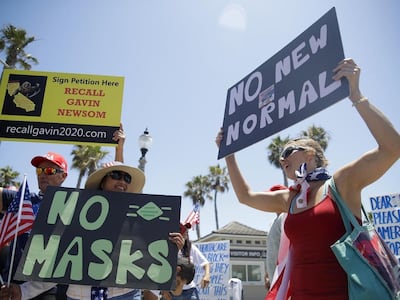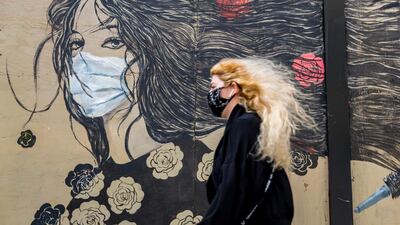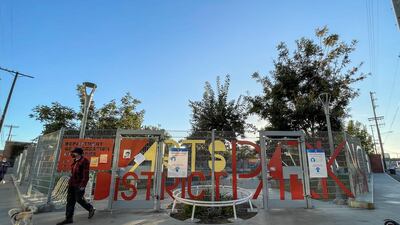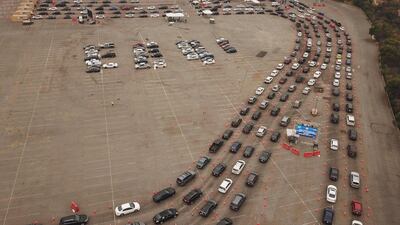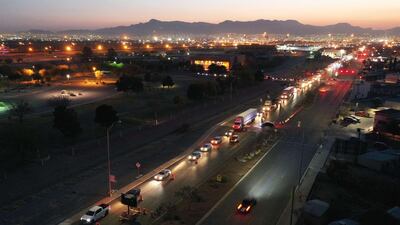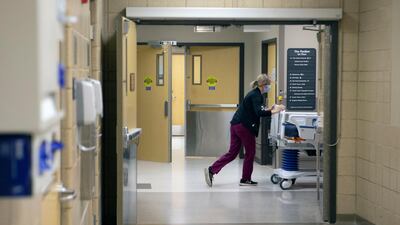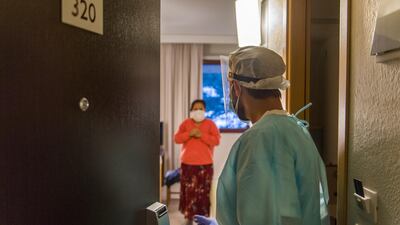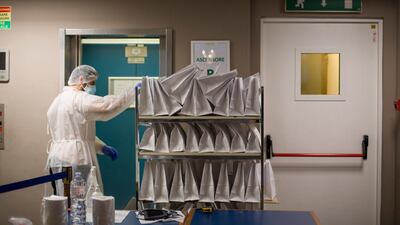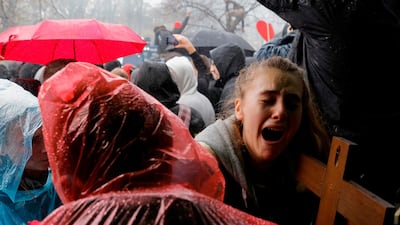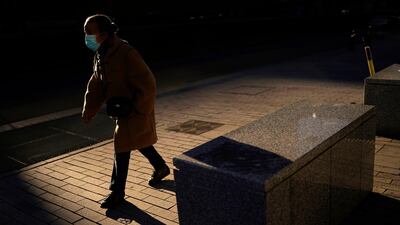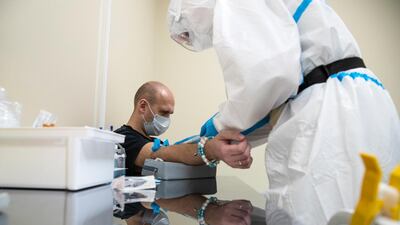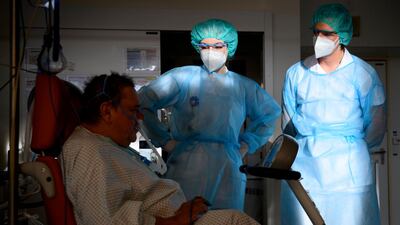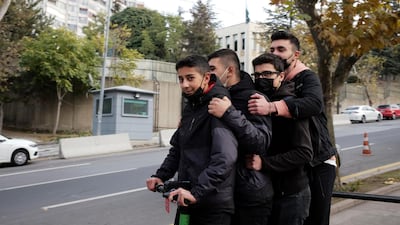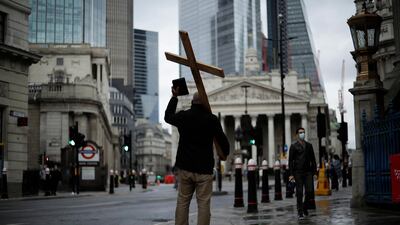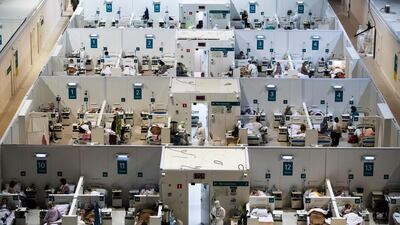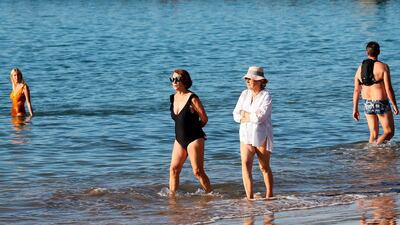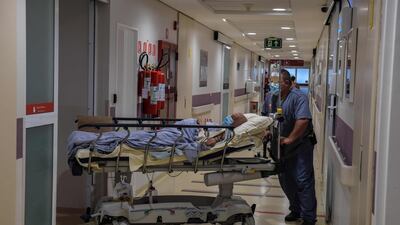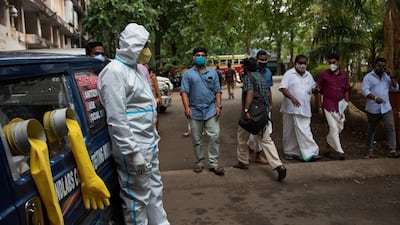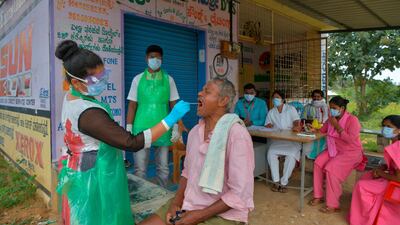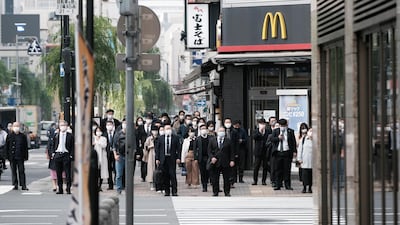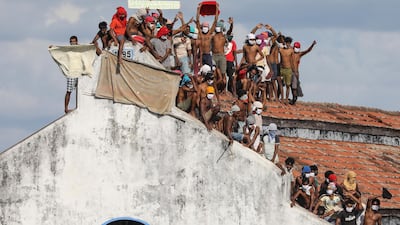With clinical trials suggesting that some coronavirus vaccines could be more than 90 per cent effective, hopes are high that a return to normal life could be on the horizon.
But just how soon could the world see an end to one of the most common measures to prevent the spread of the virus: wearing masks?
To keep infections to a minimum, the UAE has imposed stricter rules on mask wearing than many other countries, with Dh3,000 fines levied against on those who break the rules.
The World Health Organisation describes masks as “a key measure to suppress transmission and save lives” and says they should be used alongside – not instead of – other measures such as physical distancing, hand washing and good ventilation.
It could be as early as the spring, but it may be the summer, perhaps, in many countries
Vaccination programmes are considered essential if societies are to phase out mandatory use of face coverings.
But these are likely to take months at least to be completed, even in nations with early access to supplies. As a result, doctors do not expect mask wearing to end any time soon.
“Even if we do have a vaccine, it will take a longer time to get the whole population completely vaccinated. Unless that’s done, there’s always the risk of spread of infection,” said Dr Ashar Jamal, an emergency medicine doctor at Al Zahra Hospital in Sharjah, who previously had Covid-19.
Given the time that it will take to vaccinate populations, Dr Jamal predicts it will be perhaps six to eight months before the requirement to wear masks can be lifted.
Vaccines mean that, eventually, life “will probably go back to very near normal”, according to Dr Andrew Freedman, an infectious diseases specialist at Cardiff University in the UK. But he said this would depend on jabs preventing the spread of infection as well as preventing illness. He too said it was likely to be months at least before mask wearing is no longer needed.
“It could be as early as the spring, but it may be the summer, perhaps, in many countries,” he said.
Trends tracked during the Spanish flu pandemic, which began in 1918, showed that people stopped wearing masks quickly once rules changed.
Dr J Alex Navarro, of the University of Michigan’s Centre for the History of Medicine, researched mask wearing in the US during that pandemic for the US Defence Threat Reduction Agency and the Centres for Disease Control.
More than a decade before Covid-19 emerged, these organisations were interested in the value of mask-wearing in the event of a new disease outbreak.
Mask-wearing was compulsory in many American cities when Spanish flu was rife and was used alongside other measures such as the closure of dance halls, cinemas and billiards halls.
Ordinances requiring mask wearing were often unpopular, with San Francisco even having a campaign group called the Anti-Mask League.
Penalties for not wearing a mask started at about $5 (Dh18.37), or roughly a day’s wages for a factory worker at the time, and reached as much as $100 (Dh367.30), plus jail time.
“These non-pharmaceutical interventions did work – they slowed the circulation, they reduced the peak as well as overall mortality and morbidity,” said Dr Navarro.
Many cities lifted requirements to wear masks by November 1918, when the First World War ended, in the hope that the worst of the pandemic was over and following the “large-scale opposition” to mask wearing.
After restrictions were lifted, infection rates spiked in some areas, leading Denver, for example, to issue a new mask order.
“By then the war is over, people have been told already the epidemic is over, so you start to get epidemic fatigue, fatigue with these measures,” said Dr Navarro.
“People got back to pre-pandemic normalcy quickly – in some places too quickly.”
While mask-wearing did not continue significantly in the US after the pandemic, in other parts of the world, notably Japan, masks remained popular. Their use was further encouraged by subsequent events, such as the Great Kanto Earthquake of 1923, which created ash and smoke, by increases in pollution levels in the 1950s and higher rates of hay fever sparked by tree planting.
More recent disease outbreaks, notably Sars in 2002-04 and swine flu in 2009, and heavy air pollution, have made masks common around East Asia, including in China.
While researchers have said mask wearing in East Asia is a “descriptive norm” (a common behaviour) and an “injunctive norm” (something that society approves of), this is not mirrored in many other parts of the world.
So, once current requirements to wear masks end, some observers do not think mask wearing will remain common worldwide.
Dr Navarro noted the opposition to mask wearing in the US and, while cautioning that predicting the future is difficult, he did not see the popularity of masks in East Asia transferring to his country.
“I could be wrong but I do think we’ll see a few individuals here and there,” he said. “In terms of widespread mask use, I don’t see it happening.”
Likewise, Dr Freedman suggested that many people will happily discard their face coverings once the pandemic is over.
“I cannot imagine in countries like the UK or the UAE everyone is going to want to wear masks unless it’s really necessary,” he said.
The specs: 2018 Ducati SuperSport S
Price, base / as tested: Dh74,900 / Dh85,900
Engine: 937cc
Transmission: Six-speed gearbox
Power: 110hp @ 9,000rpm
Torque: 93Nm @ 6,500rpm
Fuel economy, combined: 5.9L / 100km
How to help
Call the hotline on 0502955999 or send "thenational" to the following numbers:
2289 - Dh10
2252 - Dh50
6025 - Dh20
6027 - Dh100
6026 - Dh200
NATIONAL%20SELECTIONS
%3Cp%3E6pm%3A%20Falling%20Shadow%3Cbr%3E6.35pm%3A%20Quality%20Boone%3Cbr%3E7.10pm%3A%20Al%20Dasim%3Cbr%3E7.45pm%3A%20Withering%3Cbr%3E8.20pm%3A%20Lazuli%3Cbr%3E8.55pm%3A%20Tiger%20Nation%3Cbr%3E9.30pm%3A%20Modern%20News%3C%2Fp%3E%0A
Company%20profile
%3Cp%3E%3Cstrong%3EName%3A%3C%2Fstrong%3E%20Belong%3Cbr%3E%3Cstrong%3EBased%3A%3C%2Fstrong%3E%20Dubai%3Cbr%3E%3Cstrong%3EFounders%3A%3C%2Fstrong%3E%20Michael%20Askew%20and%20Matthew%20Gaziano%3Cbr%3E%3Cstrong%3ESector%3A%3C%2Fstrong%3E%20Technology%3Cbr%3E%3Cstrong%3ETotal%20funding%3A%3C%2Fstrong%3E%20%243.5%20million%20from%20crowd%20funding%20and%20angel%20investors%3Cstrong%3E%3Cbr%3ENumber%20of%20employees%3A%3C%2Fstrong%3E%2012%3C%2Fp%3E%0A
Our family matters legal consultant
Name: Hassan Mohsen Elhais
Position: legal consultant with Al Rowaad Advocates and Legal Consultants.
Veere di Wedding
Dir: Shashanka Ghosh
Starring: Kareena Kapoo-Khan, Sonam Kapoor, Swara Bhaskar and Shikha Talsania
Verdict: 4 Stars
TRAP
Starring: Josh Hartnett, Saleka Shyamalan, Ariel Donaghue
Director: M Night Shyamalan
Rating: 3/5
Dark Souls: Remastered
Developer: From Software (remaster by QLOC)
Publisher: Namco Bandai
Price: Dh199
WISH
%3Cp%3E%3Cstrong%3EDirectors%3A%3C%2Fstrong%3E%20Chris%20Buck%2C%20Fawn%20Veerasunthorn%3Cbr%3E%3Cstrong%3EStars%3A%3C%2Fstrong%3E%20Ariana%20DeBose%2C%20Chris%20Pine%2C%20Alan%20Tudyk%3Cbr%3E%3Cstrong%3ERating%3A%3C%2Fstrong%3E%203.5%2F5%3C%2Fp%3E%0A
The National Archives, Abu Dhabi
Founded over 50 years ago, the National Archives collects valuable historical material relating to the UAE, and is the oldest and richest archive relating to the Arabian Gulf.
Much of the material can be viewed on line at the Arabian Gulf Digital Archive - https://www.agda.ae/en
Global state-owned investor ranking by size
|
1.
|
United States
|
|
2.
|
China
|
|
3.
|
UAE
|
|
4.
|
Japan
|
|
5
|
Norway
|
|
6.
|
Canada
|
|
7.
|
Singapore
|
|
8.
|
Australia
|
|
9.
|
Saudi Arabia
|
|
10.
|
South Korea
|
Sinopharm vaccine explained
The Sinopharm vaccine was created using techniques that have been around for decades.
“This is an inactivated vaccine. Simply what it means is that the virus is taken, cultured and inactivated," said Dr Nawal Al Kaabi, chair of the UAE's National Covid-19 Clinical Management Committee.
"What is left is a skeleton of the virus so it looks like a virus, but it is not live."
This is then injected into the body.
"The body will recognise it and form antibodies but because it is inactive, we will need more than one dose. The body will not develop immunity with one dose," she said.
"You have to be exposed more than one time to what we call the antigen."
The vaccine should offer protection for at least months, but no one knows how long beyond that.
Dr Al Kaabi said early vaccine volunteers in China were given shots last spring and still have antibodies today.
“Since it is inactivated, it will not last forever," she said.
UAE currency: the story behind the money in your pockets
Australia World Cup squad
Aaron Finch (capt), Usman Khawaja, David Warner, Steve Smith, Shaun Marsh, Glenn Maxwell, Marcus Stoinis, Alex Carey, Pat Cummins, Mitchell Starc, Jhye Richardson, Nathan Coulter-Nile, Jason Behrendorff, Nathan Lyon, Adam Zampa
Company%20profile
%3Cp%3E%3Cstrong%3EName%3A%20%3C%2Fstrong%3EEmonovo%20(previously%20Marj3)%0D%3Cbr%3E%3Cstrong%3EBased%3A%20%3C%2Fstrong%3ECairo%0D%3Cbr%3E%3Cstrong%3ELaunch%20year%3A%20%3C%2Fstrong%3E2016%0D%3Cbr%3E%3Cstrong%3ENumber%20of%20employees%3A%20%3C%2Fstrong%3E12%0D%3Cbr%3E%3Cstrong%3ESector%3A%20%3C%2Fstrong%3Eeducation%20technology%0D%3Cbr%3E%3Cstrong%3EFunding%3A%20%3C%2Fstrong%3Ethree%20rounds%2C%20undisclosed%20amount%3C%2Fp%3E%0A
Formula Middle East Calendar (Formula Regional and Formula 4)
Round 1: January 17-19, Yas Marina Circuit – Abu Dhabi
Round 2: January 22-23, Yas Marina Circuit – Abu Dhabi
Round 3: February 7-9, Dubai Autodrome – Dubai
Round 4: February 14-16, Yas Marina Circuit – Abu Dhabi
Round 5: February 25-27, Jeddah Corniche Circuit – Saudi Arabia
More from Neighbourhood Watch:
Mohammed bin Zayed Majlis
UAE currency: the story behind the money in your pockets
The specs: 2017 Ford F-150 Raptor
Price, base / as tested Dh220,000 / Dh320,000
Engine 3.5L V6
Transmission 10-speed automatic
Power 421hp @ 6,000rpm
Torque 678Nm @ 3,750rpm
Fuel economy, combined 14.1L / 100km
COMPANY%20PROFILE
%3Cp%3E%3Cstrong%3ECompany%20name%3A%3C%2Fstrong%3E%20Switch%20Foods%3Cbr%3E%3Cstrong%3EStarted%3A%3C%2Fstrong%3E%202022%3Cbr%3E%3Cstrong%3EFounder%3A%3C%2Fstrong%3E%20Edward%20Hamod%3Cbr%3E%3Cstrong%3EBased%3A%3C%2Fstrong%3E%20Abu%20Dhabi%2C%20UAE%3Cbr%3E%3Cstrong%3EIndustry%3A%3C%2Fstrong%3E%20Plant-based%20meat%20production%3Cbr%3E%3Cstrong%3ENumber%20of%20employees%3A%3C%2Fstrong%3E%2034%3Cbr%3E%3Cstrong%3EFunding%3A%3C%2Fstrong%3E%20%246.5%20million%3Cbr%3E%3Cstrong%3EFunding%20round%3A%3C%2Fstrong%3E%20Seed%3Cbr%3E%3Cstrong%3EInvestors%3A%3C%2Fstrong%3E%20Based%20in%20US%20and%20across%20Middle%20East%3C%2Fp%3E%0A
DUBAI WORLD CUP RACE CARD
6.30pm Meydan Classic Trial US$100,000 (Turf) 1,400m
7.05pm Handicap $135,000 (T) 1,400m
7.40pm UAE 2000 Guineas Group Three $250,000 (Dirt) 1,600m
8.15pm Dubai Sprint Listed Handicap $175,000 (T) 1,200m
8.50pm Al Maktoum Challenge Round-2 Group Two $450,000 (D) 1,900m
9.25pm Handicap $135,000 (T) 1,800m
10pm Handicap $135,000 (T) 1,400m
The National selections
6.30pm Well Of Wisdom
7.05pm Summrghand
7.40pm Laser Show
8.15pm Angel Alexander
8.50pm Benbatl
9.25pm Art Du Val
10pm: Beyond Reason
Five ways to get fit like Craig David (we tried for seven but ran out of time)
Start the week as you mean to go on. So get your training on strong on a Monday.
Train hard, but don’t take it all so seriously that it gets to the point where you’re not having fun and enjoying your friends and your family and going out for nice meals and doing that stuff.
Think about what you’re training or eating a certain way for — don’t, for example, get a six-pack to impress somebody else or lose weight to conform to society’s norms. It’s all nonsense.
Get your priorities right.
And last but not least, you should always, always chill on Sundays.
PRISCILLA
%3Cp%3EDirector%3A%20Sofia%20Coppola%3C%2Fp%3E%0A%3Cp%3EStarring%3A%20Cailee%20Spaeny%2C%20Jacob%20Elordi%3C%2Fp%3E%0A%3Cp%3ERating%3A%203%2F5%3C%2Fp%3E%0A
RACECARD
4.30pm Jebel Jais – Maiden (PA) Dh60,000 (Turf) 1,000m
5pm: Jabel Faya – Maiden (PA) Dh60,000 (T) 1,000m
5.30pm: Al Wathba Stallions Cup – Handicap (PA) Dh70,000 (T) 2,200m
6pm: The President’s Cup Prep – Conditions (PA) Dh100,000 (T) 2,200m
6.30pm: Abu Dhabi Equestrian Club – Prestige (PA) Dh125,000 (T) 1,600m
7pm: Al Ruwais – Group 3 (PA) Dh300,000 (T) 1,200m
7.30pm: Jebel Hafeet – Maiden (TB) Dh80,000 (T) 1,400m
Essentials
The flights
Etihad (etihad.ae) and flydubai (flydubai.com) fly direct to Baku three times a week from Dh1,250 return, including taxes.
The stay
A seven-night “Fundamental Detox” programme at the Chenot Palace (chenotpalace.com/en) costs from €3,000 (Dh13,197) per person, including taxes, accommodation, 3 medical consultations, 2 nutritional consultations, a detox diet, a body composition analysis, a bio-energetic check-up, four Chenot bio-energetic treatments, six Chenot energetic massages, six hydro-aromatherapy treatments, six phyto-mud treatments, six hydro-jet treatments and access to the gym, indoor pool, sauna and steam room. Additional tests and treatments cost extra.
Ordinary Virtues: Moral Order in a Divided World by Michael Ignatieff
Harvard University Press
Dolittle
Director: Stephen Gaghan
Stars: Robert Downey Jr, Michael Sheen
One-and-a-half out of five stars
Panipat
Director Ashutosh Gowariker
Produced Ashutosh Gowariker, Rohit Shelatkar, Reliance Entertainment
Cast Arjun Kapoor, Sanjay Dutt, Kriti Sanon, Mohnish Behl, Padmini Kolhapure, Zeenat Aman
Rating 3 /5 stars
All you need to know about Formula E in Saudi Arabia
What The Saudia Ad Diriyah E-Prix
When Saturday
Where Diriyah in Saudi Arabia
What time Qualifying takes place from 11.50am UAE time through until the Super Pole session, which is due to end at 12.55pm. The race, which will last for 45 minutes, starts at 4.05pm.
Who is competing There are 22 drivers, from 11 teams, on the grid, with each vehicle run solely on electronic power.
MANDOOB
%3Cp%3EDirector%3A%20Ali%20Kalthami%3C%2Fp%3E%0A%3Cp%3EStarring%3A%20Mohammed%20Dokhei%2C%20Sarah%20Taibah%2C%20Hajar%20Alshammari%3C%2Fp%3E%0A%3Cp%3ERating%3A%204%2F5%3C%2Fp%3E%0A%3Cp%3E%3C%2Fp%3E%0A
